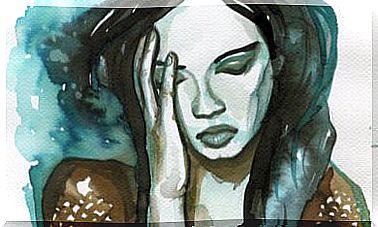5 Obsessions You May Not Know

According to the RAE, a mania is a capricious, and sometimes extravagant, concern for a certain topic or thing. This reflects that, in popular culture, being a maniac is associated with adhering to certain rigid behavior patterns that are slightly resistant to change, but perfectly avoidable at will without causing too much anxiety.
In general, a mania does not entail any problems beyond a possible and minimal waste of time, for example . But what happens if these worries and hobbies turn into obsessions?
It should be noted that, in colloquial language, the terms “mania”, “obsession” and “passion” tend to be taken as synonyms (or almost synonymous). This synonymy is not correct from the point of view of psychology, since mania refers to an excessively euphoric and thoughtless state of mind. However, establishing this parallel between the words mania and obsession makes the subject easier to understand.
One thing is clear: you can be obsessed or passionate about almost anything you can think of. Nor is there anyone who is free to be a little “maniac” and, at any moment, any of us can find ourselves engaging in ritualistic behavior.
Many of these obsessions are known to us and we know what they are called, such as, for example, melomania (obsession or passion for music). However, many others are not known to us or we do not know how to name them. Let’s see some of them.

Glazomania: obsession with lists
Glazomania is the unusual obsession, passion, or fascination with making lists. This obsession can be taken as a tool to be more efficient or even to reduce the level of stress, thanks to the fact that the lists work as a form of anticipation.
People with glazomania find that making lists helps them stay organized. You need to distinguish between being passionate about lists and other disorders like OCD or obsessive compulsive personality disorder.
In the case of OCD, in the verification OCD subtype, the presence of certain obsessions causes the appearance of compulsive behaviors, in this case of verification, to reduce anxiety. In this context, the use of lists can become a verification strategy that allows to stop the compulsion. Checking that the item “close the door” has been marked on the list , instead of going to look at the door to check it.
According to DSM-5, obsessive compulsive personality disorder consists of concern for orderliness, perfectionism, and efficiency. Among the diagnostic criteria collected for this disorder, there is concern for details, rules, lists, organization … to the point of neglecting the main objective of the activity (that is, the objective of the list itself).
Both disorders carry significant distress or impairment in social, occupational, or other significant areas of life. This characteristic is what distinguishes glazomania, or simple taste for making lists, from a disorder such as those mentioned above.
Drug addiction: obsession with taking medications
As its name suggests, drug addiction is the obsession to take medication in situations where it would not be necessary or for purposes for which a certain drug is not indicated. This concept may be related to pharmacophilia (as opposed to pharmacophobia) which is the inclination or predisposition to taking medication.
Among the disorders that may be related to this concept, we find hypochondria, as well as pain disorders and fibromyalgia. The behavior of taking a drug “just in case” or “to avoid” is related to the taking of painkillers in patients suffering from chronic pain as a pain avoidance strategy.
In the case of hypochondria, the fear of suffering from a disease can lead to the excessive intake of medications in order to preserve or improve some physiological function. An example may be the patient who takes laxative drugs daily in order to have an adequate intestinal transit and avoid the intestinal obstruction that he fears so much.
However, associated with hypochondria we also find the opposite pole, resistance to taking medication for fear of side effects.
Obsessions related to rest: catisomania and clinomania
In this area there are different obsessions related to different aspects of rest, such as lying down, sitting or, directly, sleeping. They all look very similar, but they have subtle differences that we are going to explore.
Catisomania is the obsession with sitting. It is not simply the joy of sitting, it is an irrepressible urge to sit. It can even lead to de-seating in public transport for older people or pregnant women, to sit on the floor while queuing, to sit on a clothes rack in a store, etc.
It should not be confused with clinomania, which is the obsession to lie down, nor with hypnomania, which is the obsession to sleep. In the case of clinomania, the person’s life revolves around lying in bed.
Tanorexia: obsession with being tanned
Tanorexia is the obsessive need to have a darker skin tone, that is, to be brown. It could be thought of as an addiction or a subtype of body dysmorphic disorder. These people are overly concerned about a flaw, either real or imagined (having fair skin, in this case). People with tanorexia associate tanned skin with beauty. In addition, they are considered incapable of living without sunbathing or without UVA rays.
The strategies to get a tan consist of prolonged sessions of UVA rays or long periods in the sun, usually associated with risky behaviors. For example, sunbathing or taking UVA baths without the proper use of sunscreen and even using tanning accelerators that put skin health at risk.
The beneficial effects of sunlight on our health are well known; however, prolonged or unprotected exposure increases the risk of skin problems. These can range from sunburn and sunburn, to skin cancer or melanoma, to premature aging of the skin.
The treatment of tanorexia depends on its origin. On the one hand, it can be conceptualized as an addiction or as a body dysmorphic disorder. On the other hand, sunbathing can be taken seasonally, as a form of self-management of a depressive disorder with a seasonal pattern.
In addition, we know that sunlight promotes the release of endorphins and generates a feeling of relaxation, well-being and euphoria. For this reason, in addition to psychological treatment, other ways to raise endorphins should be sought to replace the excess of sunbathing, such as exercising, listening to music, laughter or food.

Let’s reflect on obsessions
These five obsessions described here are just a small sample of the great existing repertoire. In general, they are not serious and should not be given more importance than they are. Actually, having any of these obsessions or “being a little maniac” is not bad, as long as it does not affect daily activity or cause anxiety.
We must prevent those peculiarities that make you unique and special from becoming those damn unbearable hobbies of yours. And that is achieved in a simple way: by being flexible and tolerant.
A mania cannot make us exceed certain limits in coexistence, nor can it make us want to completely control the way others act. If this happens, if a mania reduces our quality of life, it is time to consult a professional.









